In this article:
Scoliosis is a condition caused by an S- or C-shaped curve in the spine. It is most commonly observed in children but can also present itself in adulthood due to several reasons, including a genetic link and lifestyle causes. (1)(2)
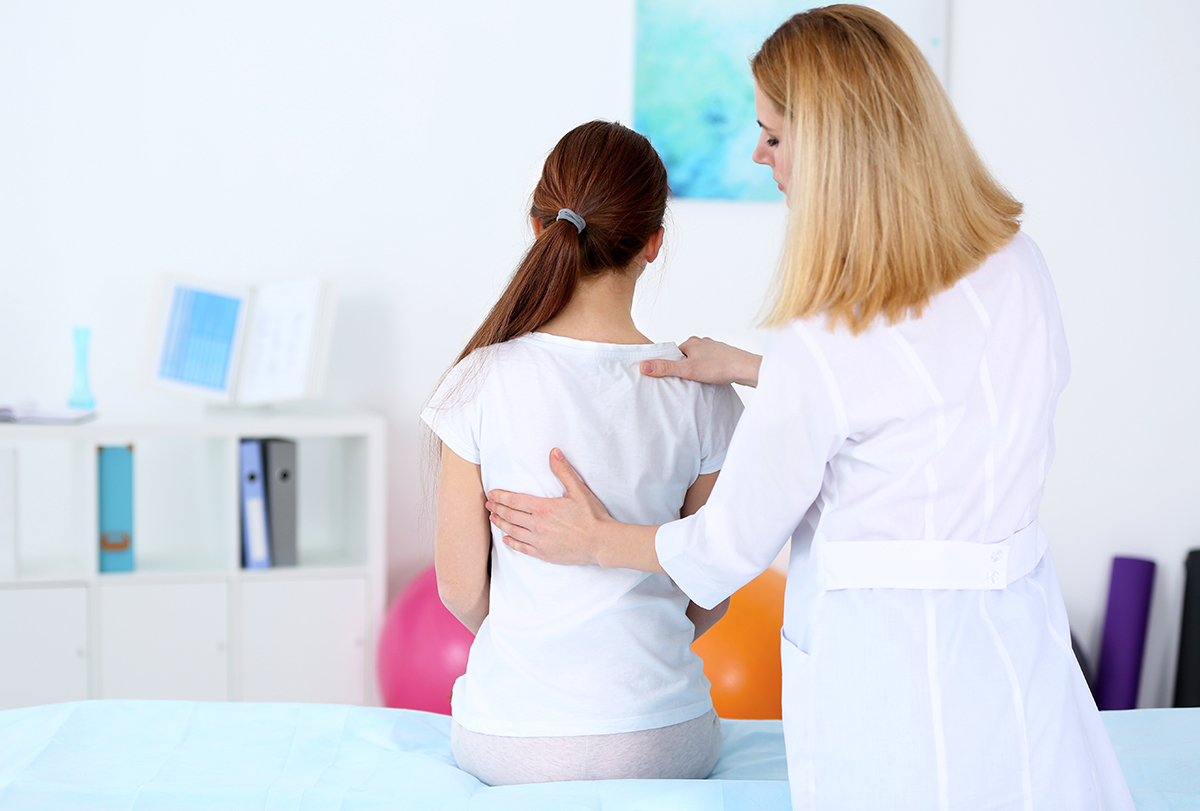
The lifestyle causes include:
- Incorrect posture
- Spinal surgery
- Accident or injury
Some cases of scoliosis will be more intense than others. In severe cases, surgery or brace support is required, while in the more easy ones, management can be done via exercise and interventions. (3)
It is best to consult a doctor to know how severe the spinal curve is and then form a treatment plan.
Managing Scoliosis
Management of scoliosis involves the following interventions.
1. Do corrective exercises
People with scoliosis may have difficulty doing normal bending and rotations, unlike those with a normal spine. Corrective exercises are usually done to alleviate their condition.
Corrective exercises may help improve dexterity (a person’s skill and agility with body movement) and overall condition in mild scoliosis, even in children. (4)(5)
Note: Please consult with your doctor before starting any home exercise program. These exercises should not replace instructions from your doctor.
Here are the corrective exercises you can do to manage and deal with scoliosis. (6)

a. One-arm reach
- Step on an elevated surface such as a box or stairstep with the leg that appears to be slightly longer in the supine position.
- As you stand on the step with one leg, lower the other one, allowing your foot to touch the ground and slightly bending your knee.
- Your arm on the side of the leg at a height should remain fixed on your waist, while the other one must be stretched as high as possible.
- Do this exercise 5–10 times and repeat twice.
- Do not perform this for the leg that appears shorter in the supine position.
b. Upward and downward dog
- Start in a plank position and slowly raise your hips as high as possible while keeping the palms of your hand and feet on the ground.
- Stay in this position for a few seconds and then lower your hips down again, as low as possible.
- Do the same 5–10 times and repeat twice.
c. Split stance and arm raise
- The leg that looks longer in the supine position has to be kept in front and slightly stretched.
- Keep your front and back straight.
- Bend the knee of the leg in front as you shift your weight forward.
- While shifting the weight forward, stretch up the arm opposite to the leg in front.
- Make sure the other leg is straightened and the knee isn’t bent.
- Do this 5–10 times and repeat twice.
- Do not perform this with the other leg forward.
2. Perform Schroth exercises
Studies have shown that Schroth exercises are beneficial for people with scoliosis. (7)
These exercises belong to a category of exercises that are recommended especially for scoliotic posture. They are designed to bring improvement in patients’ posture and also to manage pain. They also are good for endurance and strength. (8)
3. Do stretching exercises
The following stretching exercises strengthen the muscles and bring flexibility, which can help improve scoliosis, according to studies. (9)(10)(11)
a. Pelvic tilts
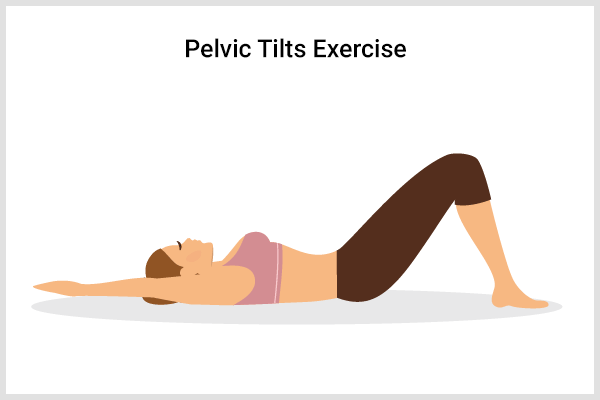
This exercise is done to strengthen the muscles of the abdomen.
- Lie in a supine position, that is, front and head facing upward.
- Make sure your feet lie flat on the floor and your knees are bent.
- As you’re lying down, tighten your abdominal muscles and bend your pelvis slightly upward.
- Hold for 5–10 seconds and repeat twice.
b. Arm and leg raise
- Lie down on the floor in the prone position, and make sure your forehead touches the ground.
- Put your arms over your head and stretch them outward.
- Keep your palms touching the floor and both your legs straight.
- Slowly, raise one arm a little higher off the ground while also raising the opposite leg.
- Hold for a few seconds.
- Repeat the exercise for the opposite side.
- Do it 5–10 times per side.
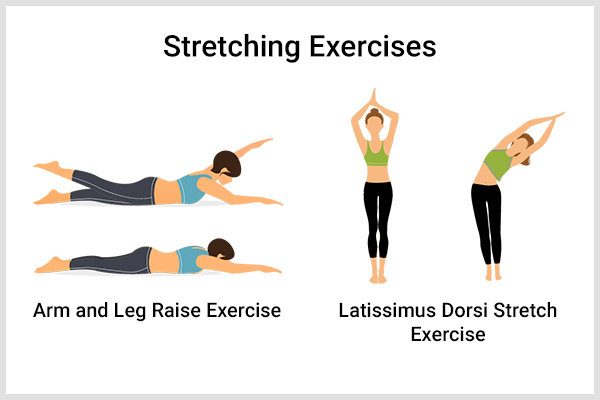
c. Latissimus dorsi stretch
The latissimus dorsi is the name of the largest muscle in the upper part of your body. Having scoliosis will affect this muscle too, so stretching it can be helpful. (12)
- Stand straight with the right posture, and keep your feet shoulder-width apart.
- Bend your knees but very slightly only.
- Take your hands over your head and hold your right wrist with your left hand or vice versa.
- Bend toward the right and hold for a few seconds.
- Repeat with the opposite side.
- Do it 5–10 times for each side.
4. Yoga-inspired exercises
The following yoga asanas can help deal with scoliosis. (13)
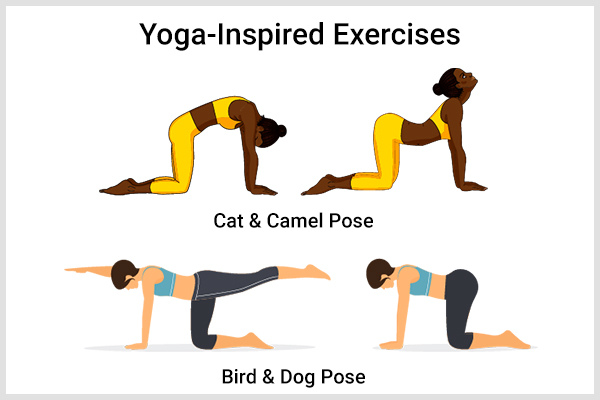
a. Cat and camel pose
The cat and camel pose is done to bring about increased flexibility to the spine and improves posture. As the name suggests, it comprises 2 poses, cat and camel, which are done alternatively.
- Start by putting your palms on the ground and your knees touching the floor. Keep your back neutral, that is, not too relaxed or stretched.
- Do the cat pose by sinking your back toward the floor while lifting your head simultaneously. Relax and breathe out.
- Do the camel pose by arching your spine up like a camel’s hump and tucking your head back in. Breathe in while doing this.
- Do this 10 times and repeat twice.
b. Bird and dog pose
- Place your hands and knees on the ground. Keep your back straight and neutral.
- Raise your right arm and left leg as you stretch them out (or vice versa). Make sure your shoulders remain parallel to the floor.
- Hold this position for a few seconds.
- Repeat for the opposite side.
- Do this 5–10 times for both sides.
5. Practicing good posture
Studies have shown that maintaining a good posture when standing, sitting, walking, and even lying down is extremely important to avoid muscle pain and postural problems.
Here are steps to achieving the right posture. (14)(15)
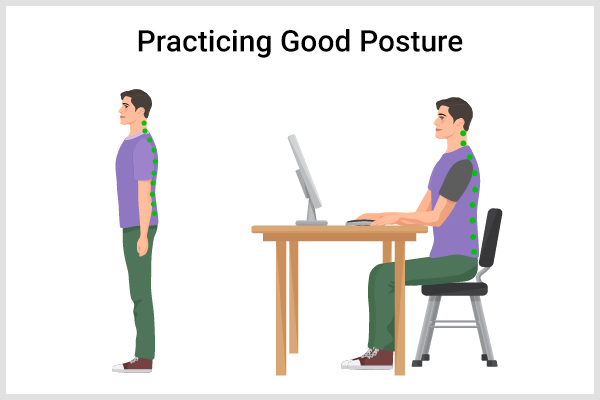
While standing
- Keep an upright posture with the shoulders relaxed.
- Keep your back straight.
- Your chin should be parallel to the floor. Shoulders should be in line with the ear holes.
- Distribute body weight on both feet.
- Tuck your abdomen in.
While sitting
- Maintain full contact between your back and the chair.
- Keep your lumbar spine supported.
- Keep your feet flat on the floor.
- Ensure minimal bend at the wrists.
- Keep elbows close to the body.
- Knees should make 90 degrees to the ground.
- Thighs should be parallel to the floor.
Different Types of Scoliosis
Based on the severity of scoliosis
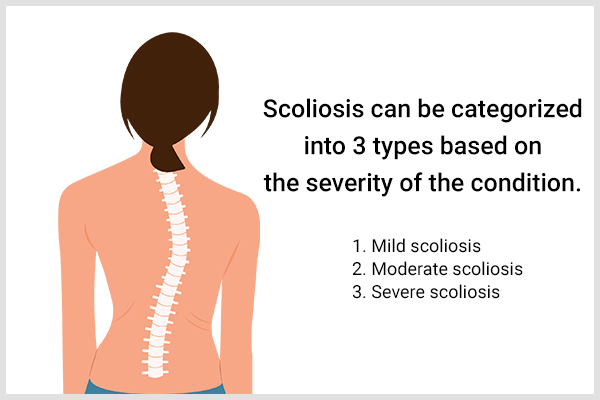
Scoliosis can be categorized into three types based on the severity of the condition.
1. Mild scoliosis
Mild scoliosis is s defined as scoliosis where the curve in the spine is lesser than 20 degrees. It is not very visible to the naked eye as the postural curve is not very noticeable and may not require any significant medical help.
Mild scoliosis responds very well to corrective and other exercises if the exercises are done regularly with utmost sincerity. (16)
2. Moderate scoliosis
Moderate scoliosis is defined as a spinal curve that is somewhere between 40 and 45 degrees. (16) It can also be treated with exercise, but sometimes, it may require significant medical help such as bracing.
3. Severe scoliosis
Severe scoliosis calls for medical attention and is mainly corrected with surgery of the spine.
Based on the cause of scoliosis
Scoliosis can be categorized into the following based on the cause of the condition.
1. Idiopathic scoliosis
Idiopathic scoliosis is the most common type and the exact cause of scoliosis remains unknown. There are three types of idiopathic scoliosis: infantile scoliosis, juvenile scoliosis, and adolescent scoliosis. (17)
2. Congenital scoliosis
Congenital scoliosis is caused by abnormalities in vertebrae development. (17)
3. Neuromuscular scoliosis
Neuromuscular scoliosis is caused by underlying neuromuscular conditions such as cerebral palsy (a neurological disorder that affects movement and coordination) or muscular dystrophy (a genetic disorder that causes progressive muscle weakness and degeneration). (17)
Note: Tumors that affect the vertebrae can also cause scoliosis.
Factors Affecting Scoliosis
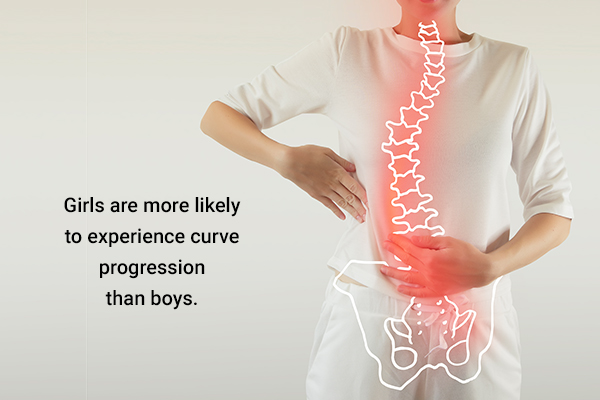
Several factors can affect the progression of scoliosis:
- Girls are more likely to experience curve progression than boys.
- Curves are more likely to progress during growth periods, such as during adolescence.
- Double curves, which affect both the thoracic spine and lumbar spine, are more likely to progress than single curves that only affect the thoracic spine.
Most-Asked Questions About Scoliosis
How can mild scoliosis be managed without medical help?
Mild scoliosis is highly responsive to nonsurgical interventions and lifestyle modifications. These include: (18)
- Exercising
- Scoliosis-specific physiotherapy
- Chiropractic
- Yoga
- Pilates
What is bracing in scoliosis?
A scoliosis brace is worn under clothing and plays a supportive role in improving the exaggerated curve of the spine in scoliosis. It is like a stiff jacket made out of plastic that keeps the spine in place. It is also called orthosis and is available in different variations and types. (19)
When do people go for surgery for scoliosis?
According to experts, surgery is indicated for scoliosis when: (20)
- Bracing is not likely to be effective due to a large curve size.
- The curve’s location makes it difficult to brace, such as a double thoracic curve.
- A curve continues to worsen in a growing child.
- There is a loss of spinal balance.
- Cosmetic reasons are considered.
If I have scoliosis, will my child get it?
Scoliosis is not to be passed down in families. So, if you suffer from scoliosis, the chances of your children having it too are pretty low.
Although it can’t be prevented, you can look for early signs for timely interventions. (21)
In what position do I sleep if I have scoliosis?
If you have scoliosis, do not sleep on your stomach, as this puts stress on the spine. You can use pillows to support your curve for some comfort. (22) Also, sleep on a firm mattress.
Final Word
Exercising is a helpful intervention when it comes to managing either mild or moderate scoliosis. If you do the exercises regularly, you can slow down the curvature in your spine and also manage the symptoms such as pain.
Stretching and yoga can be done for flexibility, which is helpful if you suffer from scoliosis. It is, however, always important to talk to a professional care provider to design the right treatment plan for you.
- Was this article helpful?
- YES, THANKS!NOT REALLY


